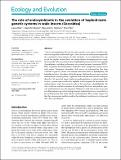Files in this item
The role of endosymbionts in the evolution of haploid-male genetic systems in scale insects (Coccoidea)
Item metadata
| dc.contributor.author | Ross, Laura | |
| dc.contributor.author | Shuker, David Michael | |
| dc.contributor.author | Normark, Benjamin B. | |
| dc.contributor.author | Pen, Ido | |
| dc.date.accessioned | 2013-02-13T10:31:01Z | |
| dc.date.available | 2013-02-13T10:31:01Z | |
| dc.date.issued | 2012-05 | |
| dc.identifier | 45508223 | |
| dc.identifier | 545a4e65-4846-434d-911c-4379fedf958b | |
| dc.identifier | 000312447700019 | |
| dc.identifier | 84879387079 | |
| dc.identifier.citation | Ross , L , Shuker , D M , Normark , B B & Pen , I 2012 , ' The role of endosymbionts in the evolution of haploid-male genetic systems in scale insects (Coccoidea) ' , Ecology and Evolution , vol. 2 , no. 5 , pp. 1071-1081 . https://doi.org/10.1002/ece3.222 | en |
| dc.identifier.issn | 2045-7758 | |
| dc.identifier.uri | https://hdl.handle.net/10023/3355 | |
| dc.description.abstract | There is an extraordinary diversity in genetic systems across species, but this variation remains poorly understood. In part, this is because the mechanisms responsible for transitions between systems are often unknown. A recent hypothesis has suggested that conflict between hosts and endosymbiotic microorganisms over transmission could drive the transition from diplodiploidy to systems with male haploidy (haplodiploidy, including arrhenotoky and paternal genome elimination [PGE]). Here, we present the first formal test of this idea with a comparative analysis across scale insects (Hemiptera: Coccoidea). Scale insects are renowned for their large variation in genetic systems, and multiple transitions between diplodiploidy and haplodiploidy have taken place within this group. Additionally, most species rely on endosymbiotic microorganisms to provide them with essential nutrients lacking in their diet. We show that species harboring endosymbionts are indeed more likely to have a genetic system with male haploidy, which supports the hypothesis that endosymbionts might have played a role in the transition to haplodiploidy. We also extend our analysis to consider the relationship between endosymbiont presence and transitions to parthenogenesis. Although in scale insects there is no such overall association, species harboring eukaryote endosymbionts were more likely to be parthenogenetic than those with bacterial symbionts. These results support the idea that intergenomic conflict can drive the evolution of novel genetic systems and affect host reproduction. | |
| dc.format.extent | 11 | |
| dc.format.extent | 943128 | |
| dc.language.iso | eng | |
| dc.relation.ispartof | Ecology and Evolution | en |
| dc.subject | Bacterial symbiont cardinium | en |
| dc.subject | Mealybugs hemiptera | en |
| dc.subject | Haplodiploidy | en |
| dc.subject | Haplodipoidy | en |
| dc.subject | Wolbachia | en |
| dc.subject | Endosymbiosis | en |
| dc.subject | Phylogenetic congruence | en |
| dc.subject | DiaspIdidae | en |
| dc.subject | Male killers | en |
| dc.subject | Genomic conflict | en |
| dc.subject | Sex-ratios | en |
| dc.subject | Paternal genome elimination | en |
| dc.subject | Scale insects | en |
| dc.subject | Classification | en |
| dc.subject | Parthenogenesis | en |
| dc.subject | QL Zoology | en |
| dc.subject | QH426 Genetics | en |
| dc.subject.lcc | QL | en |
| dc.subject.lcc | QH426 | en |
| dc.title | The role of endosymbionts in the evolution of haploid-male genetic systems in scale insects (Coccoidea) | en |
| dc.type | Journal article | en |
| dc.contributor.institution | University of St Andrews. School of Biology | en |
| dc.contributor.institution | University of St Andrews. Scottish Oceans Institute | en |
| dc.contributor.institution | University of St Andrews. Institute of Behavioural and Neural Sciences | en |
| dc.contributor.institution | University of St Andrews. Centre for Biological Diversity | en |
| dc.identifier.doi | 10.1002/ece3.222 | |
| dc.description.status | Peer reviewed | en |
This item appears in the following Collection(s)
Items in the St Andrews Research Repository are protected by copyright, with all rights reserved, unless otherwise indicated.

